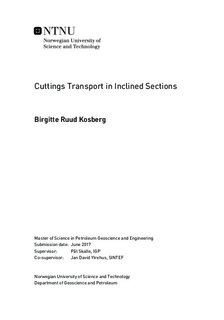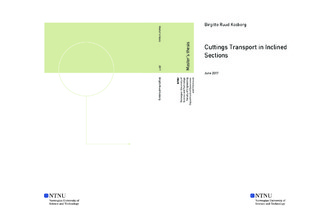| dc.description.abstract | Mud rheology is a key parameter in hole cleaning efficiency. Field data suggests that oil-based drilling fluids perform better compared to water based drilling fluids in the field, even with identical rheological properties, without it being fully understood. Studies and experimental work is conducted to see the rheological properties in context with cuttings transport in inclined and horizontal wellbores. Cuttings particles settling in the wellbore can result in mechanical pipe sticking and unfortunate cost- and safety-hazards. Operational parameters as annular velocity and drill pipe rotation can influence the hole cleaning efficiency significantly. Models are developed to estimate cuttings bed height based on operational data and rheology. The literature study suggests that the field is in need of a universal model to be utilized for all cases.
The objective of this thesis was to engage in a hole cleaning experiment conducted by SINTEF Petroleum. Set-up of a semi full-scale flow loop and monitoring rheological properties over time during experiments was performed. Remaining fluid control will ensure that the mud keeps the original quality without unfortunate effect to the experiments. The experimental procedure was evaluated in published work by testing by testing samples of Laptonite-fluids, and for this thesis, an oil-based WARP fluid, in Anton Paar and Fann 35. Fluids were tested with 0h and 24h resting time, with and without pre-stirring.
Cuttings transport was modelled for inclined and horizontal boreholes. The model estimates the cuttings bed height as a function of velocity and rotation of the drill pipe in annuli. The critical, local velocity where the sum of forces acting upon a cuttings particle is zero is utilized to find the cuttings bed height without rotation. The mass balance between shear force acting on the bed by the rotating drill pipe and gravitational forces is used to estimate the height which cuttings are transported up from the bed and if the height is sufficient to transport the particle out of the section by axial drag forces along annuli.
Pre-stirring of the sample prior to measuring the flow curve in accordance to API specifications, show clear advantage for reproducing results for both OBM WARP and Laptonite-fluids. Pre-stirring of Laptonite-fluids show highest effect of pre-stirring at low salt concentrations. While Laptonite fluid seem to be affected by gel strength without pre-stirring, while OBM WARP has the opposite effects with less shear stress compared to samples without pre-stirring.
The cuttings bed model shows higher effect of increasing velocity and rpm, compared to experimental data. The extreme estimated values are a result of uncertainty of input values, simplifications and assumptions. The fluid mechanics of cuttings transport is requires more comprehensive modelling. Research in developing well-fitted fluid models for drilling fluids, as well as a statistical method in analysing a flow pattern with both different flow regimes in the axial and cross-sectional directions, should be in focus in the future. | |

